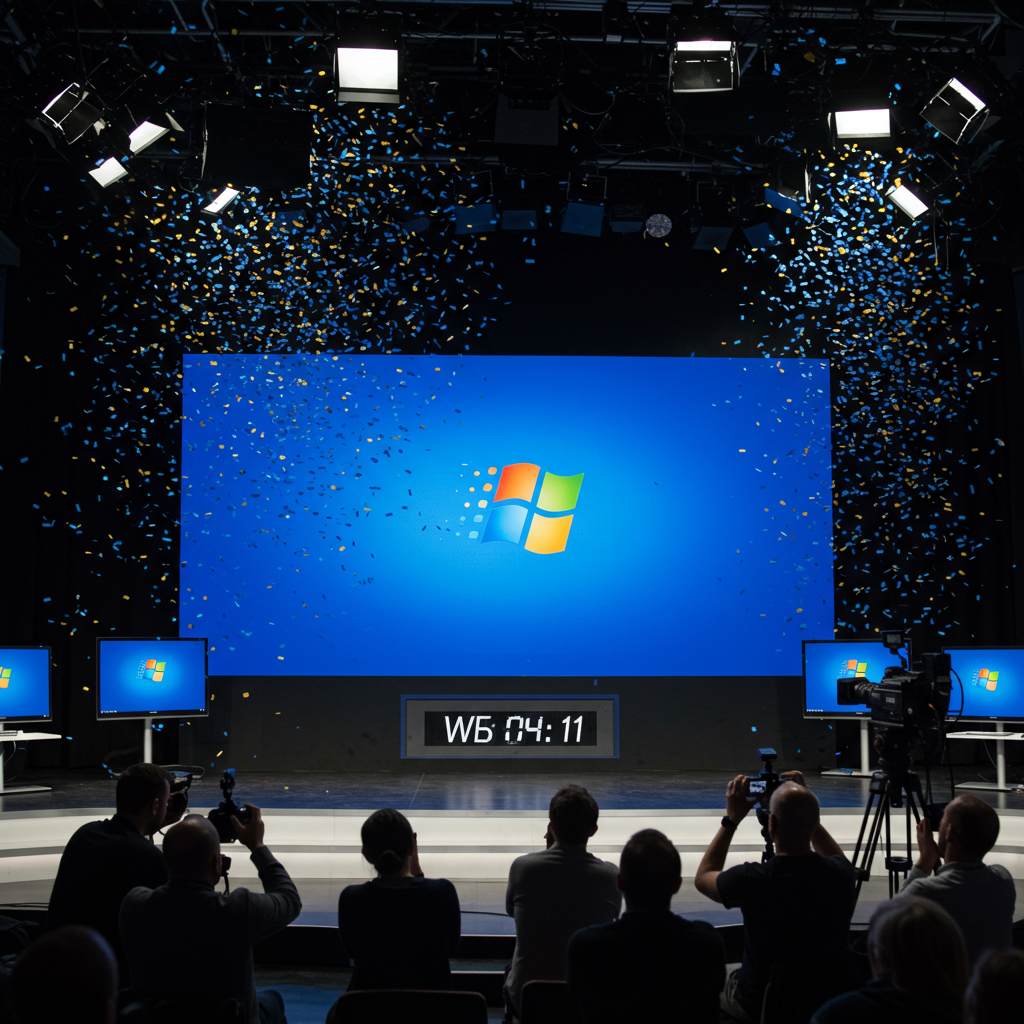For decades, windows users instantly recognized the stark blue screen signaling a critical system failure. Known universally as the “Blue Screen of Death,” or BSOD, this infamous error screen has been a fixture since the earliest days of the Windows operating system, serving as a dreaded herald of PC crashes. Now, after nearly 40 years, Microsoft is making a significant change: the iconic blue error screen is being retired, replaced by a new black version as part of an upcoming Windows 11 update. This shift goes beyond just color; it brings functional changes aimed at faster troubleshooting and recovery.
The End of an Era: Saying Goodbye to the Blue Screen
The Blue Screen of Death first appeared with Windows 1.0 back in 1985. Its bright blue background with white text became instantly recognizable, a symbol often associated with frustration and data loss. Over the years, the information displayed on the screen evolved, sometimes including a simple, sad emoticon face “:(” or a QR code for troubleshooting help with Windows 10. This error screen pops up when the Windows operating system encounters a critical failure it cannot recover from, forcing the system to halt or restart. Its long history has cemented its place in computing lore and popular culture, inspiring countless memes, online communities, and even merchandise.
Why the Change? More Than Just a New Color
Microsoft states that the move to a black screen, officially termed a “simplified UI for unexpected restarts,” isn’t merely cosmetic. This significant alteration is deeply integrated into the “Windows Resiliency Initiative.” Launched recently, this broader effort focuses on enhancing both the stability and security of Windows systems. The goal is to make Windows more robust and reliable, especially in the face of unforeseen errors or external disruptions. Streamlining the experience of unexpected restarts is a key objective.
Introducing the New Black Screen of Death
Set to roll out later this summer with Windows 11, version 24H2, the new black error screen will replace the blue one. Visually, it presents a minimalist look. The well-known frowny face emoticon is gone, as are the QR codes introduced in Windows 10. The text has been simplified and shortened, changing from phrases like “An error has occurred” to the less alarming “Your device ran into a problem and needs to restart.” The language now uses “device” instead of “PC,” reflecting the broader range of hardware running Windows today. While less visually cluttered, it still provides essential technical details required for diagnosing issues.
Enhanced Troubleshooting for IT Professionals
One of the most important functional improvements of the new black screen targets IT administrators and advanced users. Unlike some previous iterations where additional debugging software might be needed to fully understand the crash details, the new screen will directly display crucial information. Specifically, it will show the stop code and identify the faulty system driver that triggered the critical error. This streamlined presentation is designed to allow administrators to more quickly pinpoint the source of the problem. Faster diagnosis is a critical step toward faster resolution and machine recovery.
The ultimate aim of these changes, according to Microsoft, is to significantly reduce the recovery time after a PC crash. The stated target is an ambitious recovery time of just 2 seconds. This rapid recovery is essential for businesses and individuals who rely heavily on uninterrupted system availability.
The Windows Resiliency Initiative and Real-World Impact
The context for the Windows Resiliency Initiative underscores the importance of system stability in today’s interconnected world. Microsoft’s focus on enhancing resilience was prompted, in part, by recent large-scale incidents. The 2024 CrowdStrike outage is specifically mentioned as a catalyst. This widespread event caused significant disruption, taking systems offline for numerous businesses, airports, and governmental services globally, affecting over 8 million devices. Lessons learned from such incidents highlight the critical need for operating systems to be able to recover quickly and reliably from unexpected failures. The transition to the black error screen, with its improved diagnostic capabilities, is a direct outcome of this focus on real-world system resilience and security.
Cultural Significance and User Reaction
For many long-time Windows users, the Blue Screen of Death is more than just an error message; it’s a piece of computing history. Its frequent, often ill-timed appearances have woven it into the fabric of pop culture. The removal of such a recognizable icon is bound to evoke a range of reactions, from relief that a symbol of frustration is gone to nostalgia for a familiar, albeit unwelcome, sight. Some might find the new black screen visually less distinctive or perhaps even more somber (“reminiscent of a funeral” as one author noted). The shift raises interesting questions about how users perceive system errors when presented in a new way. Will the black screen ever achieve the same level of notoriety or cultural penetration as its blue predecessor? Only time will tell, but it’s clear that a significant visual and functional chapter in the Windows story is closing.
What This Means for Users and IT
For most everyday Windows 11 users, encountering the new black screen will likely feel different primarily due to the color and simplified text. While less visually jarring, the core purpose remains the same: indicating a critical failure requiring a restart. For IT professionals and advanced home users comfortable with troubleshooting, the direct display of the stop code and faulty driver is a welcome improvement. This change potentially saves time by reducing the need to dig for this information using separate tools. It streamlines the first step in the diagnostic process.
While the official rollout timeline hasn’t been explicitly placed on a public Windows roadmap, its appearance in preview builds indicates it’s nearing release. Users of Windows 11, version 24H2, should expect to see this change arrive sometime later this summer, likely through a standard Windows update. This transition marks Microsoft’s deliberate step towards a more functional, less culturally burdened, and hopefully faster-recovering error reporting system for its vast user base.
Frequently Asked Questions
What is the new Black Screen of Death replacing on Windows 11?
The new Black Screen of Death is directly replacing the long-standing Blue Screen of Death (BSOD), which has been the critical system error screen on Windows operating systems since 1985. For nearly 40 years, the blue screen signaled system crashes. The new black screen takes over this function starting with Windows 11, version 24H2, eliminating the traditional blue color, the sad emoticon, and QR codes, presenting a simplified visual interface for unexpected restarts.
When can I expect to see the new Black Screen of Death on my Windows 11 device?
Microsoft plans to roll out the new Black Screen of Death later this summer. This change is scheduled to appear on all devices running Windows 11, version 24H2. While an exact date isn’t confirmed on the public roadmap, the feature has appeared in preview builds and is anticipated to arrive via an upcoming standard Windows update for eligible systems. Users will see the black screen instead of the familiar blue one when a critical system error occurs.
How does the Black Screen of Death help troubleshoot PC errors faster than the old BSOD?
The new Black Screen of Death is designed to improve the diagnostic process, particularly for IT professionals and advanced users. Unlike the old Blue Screen of Death which sometimes required separate debugging software, the black screen directly displays crucial information needed for troubleshooting. It shows the specific stop code that identifies the type of error and pinpoints the faulty system driver responsible for the crash. This immediate access to key details allows for quicker diagnosis and facilitates faster recovery of the system, aiming for recovery times as short as 2 seconds.
Conclusion
The departure of the Blue Screen of Death marks the end of a four-decade era for Windows users. While its cultural impact is undeniable, the move to the new black screen in Windows 11 signifies Microsoft’s commitment to improving system reliability and recovery. As part of the broader Windows Resiliency Initiative, this change is designed to provide IT administrators and advanced users with faster, more efficient tools for diagnosing critical system errors. The simplified interface and direct display of essential information aim to reduce downtime and streamline the process of recovering from unexpected restarts. As Windows continues to evolve, even its most infamous features are subject to change in the pursuit of a more stable and secure computing experience.
Word Count Check: 974




